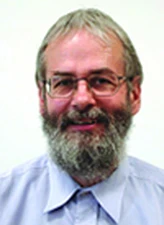Ulrich R. Christensen

The 2009 Augustus Love Medal is awarded to Ulrich R. Christensen for his fundamental contributions to geodynamics through studies of sub-solidus and the mantles of other terrestrial planets and rotating convection and magneto-convection aimed at probing the planetary interiors throughout the solar system.
Professor Ulrich Christensen an international leader in geodynamics. His main research tool is computer modeling and his skill is being able to clearly identify the fundamental questions and to shed light on them by developing sophisticated computer simulations and comparing their results to observations. He is known for his own distinctive scientific style. He begins by systematically exploring some dynamical process in its most fundamental terms, usually by constructing a numerical model that incorporates all of the critical physical and chemical interactions, and then he carefully distills the model results before comparing them with observations, a technique designed to shed the maximum amount of light on the geophysical phenomenon in question. It is his insistence on developing a systematic understanding of the fundamental dynamics that explains why his papers are so widely studied and have such remarkable impact and longevity.
To illustrate the breadth of his research in geodynamics and related fields, one may look at contributions for the study of sub-solidus convection of Earth’s mantle. He has focused on the evolution of subducting slabs and the effects of phase boundaries in the mantle, and established the dynamical criteria for lithospheric slab penetration through the mantle transition zone, including the effects of phase changes plus thermal, compositional, and rheologic gradients. He also demonstrated how reactive chemical tracers mix and accumulate in the lower mantle due to the interaction of deep mantle convection with the transition zone, thereby addressing fundamental difficulties in our understanding of the long-term chemical evolution of the Earth. He systematically studied rising plumes below a moving plate and at a spreading ridge, and developed the leading dynamically self-consistent model of a three-dimensional mantle plume structure that is now used to guide deep drilling on the Hawaiian Islands. The challenge in mantle convection stimulations is the representation of the highly temperature and stress dependent viscosity. Professor Christensen produced some of the first computer models of variable viscosity mantle convection, and applied them to systematize the effects of temperature- and pressure-dependent viscosity on heat loss from the convecting mantle. For rotating convection he presented the first successful numerical model of high velocity convectively-driven zonal flows in the deep atmospheres of the gas giants Jupiter and Saturn. For magneto-convection, he simulated more than a hundred 3D convective dynamos to gain an understanding of how the flow and field structures depend on various parameters. He derived experimentally- and numerically-based scaling laws for predicting planetary dynamo properties, including internal magnetic field strength, convective velocity, and energy dissipation rates. He has made the most comprehensive analysis of how mantle thermal heterogeneity affects the geodynamo, including the clustering of polarity reversal paths and the modifications to the time-averaged geomagnetic field structure. All of these contributions have been widely recognized. As a demonstration that his innovative research style continues, One can point to his 2006 Nature article, arguing that Mercury’s anomalously weak external magnetic field is induced by dynamo action deep within its core, a proposal which is due be tested by two spacecraft missions in the coming years.
Professor Christensen has a long record of being actively involved in international committees and conferences and has provided excellent guidance to his students and postdocs. He organized the very successful computer modeling benchmark for 3D spherical dynamo models, which has become the standard test for old and new models in the geodynamo community. He is a recipient of the Gerhard-Hess award of the German Research Foundation (DFG), a winner of Gottfried-Wilhelm Leibniz Prize, he is an elected member of the Göttinger Academy of Sciences and the Deutsche Akademie der Naturforscher Leopoldina (the national German science academy), a fellow of the American Geophysical Union, as well as an honorary fellow of the European Union of Geosciences. He is the Director of the Max-Planck Institut fur Aeronomie and therefore now devotes much of his time to planetary missions. I give my strongest support for the nomination of Ulrich Christensen for the Love Medal.
